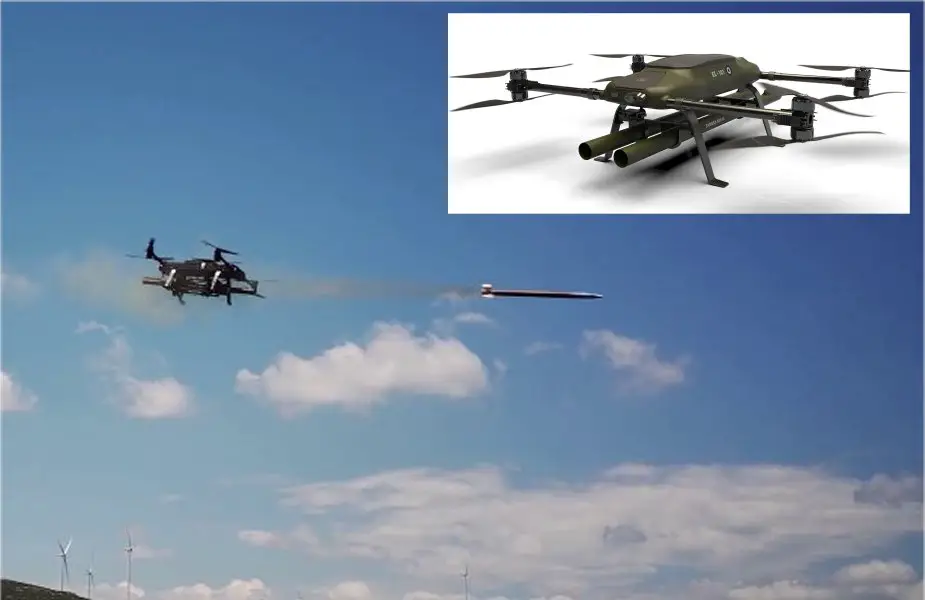According to a tweet by SAS Technology on July 24, 2023, the weaponized drone SARISA SRS-1A recently completed a second successful test involving 2.75" (70mm) rockets. This test was carried out under the supervision of the Hellenic Air Force (HAF) and took place at the shooting range of the General Directorate of Defense Equipment and Investments (GDAEE).
Follow Air Recognition on Google News at this link
 Sarisa SRS-1A weaponized drone successfully completes second test with 70mm rockets (Picture sources SAS Technology)
Sarisa SRS-1A weaponized drone successfully completes second test with 70mm rockets (Picture sources SAS Technology)
SAS Technology collaborated with the Hellenic Aerospace Industry (EAS) on the Sarisa Unmanned Aerial Vehicle (UAV) program. Additionally, Thales Belgium, a unit of the Thales Group, provided support by supplying test ammunition and issuing certification for the SRS-1A's use with 70mm rockets.
During the test, the drone demonstrated its launcher angle adjustment system, precise targeting capabilities even in challenging wind conditions, and reduced rocket exhaust effects through aerodynamic and mechanical interventions.
With the successful test, SAS Technology is now preparing for operational tests using production models of the SARISA UAV. The Hellenic Armed Forces have been briefed on the capabilities of the UAV, along with other systems developed by SAS Technology, and proposals for cooperation between the company and the Armed Forces have been presented.
SAS Technology takes pride in its self-funding initiatives, showcasing its technological sufficiency and innovation, which has attracted international defense manufacturers' interest in potential collaborations. Collaboration with the Armed Forces and the government is considered essential for the future development of the defense industry in Greece.
Proposals have been suggested to relevant authorities for joint tests in realistic operational scenarios, involving live firings of guided and unguided 2.75" rockets, aiming to further assess the UAV Sarisa system's capabilities.
The SARISA is a heavy-weight multirotor UAV, developed by Spirit Aeronautical Systems S.A., based in Greece. It measures 165 cm in length, 218 cm in width, and 45 cm in height. The drone's maximum takeoff weight is 60 kg, allowing it to carry substantial payloads. Its flight time varies depending on the payload and mission circumstances, with a continuous flight of 20 minutes possible with maximum payload.
The drone platform offers a range of benefits through its interchangeable payload racks, providing flexibility for different types of missions. It can be configured for tactical air-to-ground assault, serving as a weaponized aerial platform with various weapon systems. Alternatively, it can be set up for tactical cargo missions with a cargo-carrying rack, enabling efficient resupply operations. Additionally, the SARISA can be equipped with a sprayer tank rack for aerial spraying tasks related to agriculture or environmental protection efforts. This versatility allows the SARISA to adapt to specific mission requirements effectively, making it a valuable asset in diverse scenarios.
The Sarisa SRS-1A, specifically designed for military applications, is a heavyweight multirotor drone with a maximum takeoff weight exceeding 60 kg and a payload capacity of at least 25 kg. It stands out for its flexibility, thanks to interchangeable payload carriers, making it adaptable for various mission scenarios. The drone can be configured with single or dual rocket launcher racks, capable of accommodating different rockets, including the widely used 2.75-inch/70mm diameter Hydra 70 rocket launchers, enabling tactical air-to-ground attacks to support ground units in combat situations.
The Hydra 70 rocket is extensively utilized by NATO armed forces and is commonly deployed on light attack ground vehicles or helicopters like the AH-64 Apache.
Another configuration option is the tactical cargo carrier, allowing the Sarisa SRS-1A to undertake resupply missions for military units, facilitating logistical operations. Additionally, the drone can be fitted with a spray tank rack for aerial spraying missions, applicable in both military and civil applications.
Furthermore, another variant of the weaponized Sarisa is the Sarisa SRS-1R26. This UAV is equipped with an in-flight releasable rack capable of carrying up to four RPG-26 launchers, each equipped with the SFM-26A (RPG26 Servo Firing Mechanism). This configuration enables the UAV to engage targets from the air at close to medium distances effectively, without risking human life.
The SFM-26A, a Servo Firing Mechanism designed by SAS Technology, allows the UAV to remotely engage targets by providing capabilities for target acquisition, arming, and firing, all operated remotely without the need for a human presence near the target. Safety systems, such as a hard safety pin that is removed before flight and a servo-operated trigger cover, ensure proper control and prevent accidental or unauthorized firing.
Integrating RPG-26 launchers on a UAV like the SARISA SRS-1R26 expands the operational capabilities of the RPG-26, originally a close-range combat system, as it can now engage targets from the air, increasing its reach and versatility on the battlefield.
















